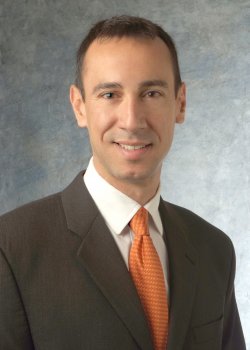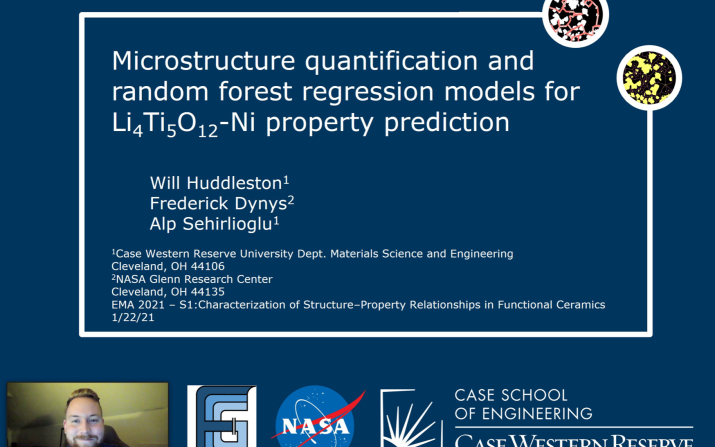
Students present at EMA 2021 conference, Huddleston wins oral competition

The Department of Materials Science and Engineering at CWRU was well represented at the American Ceramic Society’s annual Electronic Materials and Applications conference. Three undergraduate students, Matthew Hoffman, Bridget Powers Beggs and Hugh Smith, gave poster presentations, while Associate Professor Alp Sehirlioglu, 2020 PhD graduate Kevin Pachuta and three PhD candidates, Elahe Farghadany, Kimberly Gliebe and William Huddleston, gave oral presentations. Huddleston’s presentation, “Microstructure quantification and random forest regression models for Li4Ti5O12–Ni property prediction,” won first place in the student oral competition.
While doing research for his oral presentation, “Structure and Properties of Chemical Treated Lithium Cobalt Oxide and Cobalt Oxide Nanosheets,” Pachuta made some unexpected discoveries. “This work goes to show that the most interesting things in your research are not always what you initially set out to discover,” he said. “For example, my research focused heavily on the processing and exfoliation of lithium cobalt oxide to cobalt oxide nanosheets. As it turns out the particles that I produce make for great catalysts and it was interesting learning about this field and applying my expertise to tune the performance of these particles.” Pachuta, who is now a postdoc scholar at CWRU, used a wide range of processing and characterization methods for studying the properties of chemically treated lithium cobalt oxide and cobalt oxide nanosheets for his research.
Farghadany’s oral presentation, “Investigating the formation mechanism of the surface features in NLTO epitaxial thin film,” focused mainly on epitaxial thin film processing optimization and structural characterization of a complex oxide system; (Nd,Li,vacancy)TiO3, particularly surface studies and the thin film's surface reacts to cooling rate. She primarily conducted her experiments by Atomic Force Microscopy (AFM) and is working to connect the surface features with the microstructure of the film at different thermodynamic conditions.
Powers Beggs characterized images of Farghadany’s thin films for her poster, “Topographic Image Analysis of Surface Morphology as a Function of Cooling Rate in (Nd,Li)TiO3 Thin Films.” She primarily used image and data analysis techniques, such as segmentation and morphological operations. “The mathematical processes behind image analysis operations were very interesting to me,” said Powers Beggs. “Visually seeing the effect of a mathematical operation that I normally would just be writing out as an equation on a real-life image was very exciting. Additionally, it was interesting to see a real life example of the nucleation and growth behavior that I learn about in my classes.”
Gliebe’s presentation, "Machine learning based analysis of kinetics of film growth by PLD," focused on understanding the kinetics during growth of novel thin film materials for future devices. While conducting the research for her presentation, she looked at samples using atomic force microscopy and x-ray diffraction. She grew films using pulsed laser deposition and real time diffractometry and analyzed machine learning after the growth was completed. “Some of the most interesting results were how machine learning can identify the different stages of thin film growth and what those stages look like in the RHEED pattern,” she said. “All of this information helps me to understand the fundamentals of RHEED and will help me to grow better films in the future.”
Smith used a mathematical approach to study the electrical behavior of his poster’s titular heterostructure for his presentation, “tr-KPFM Measurements on the Surface LaAlO3/SrTiO3 Heterostructures.” He has done research on the aforementioned structures analyzing the composition and electrical behavior. This was his first conference. Smith’s presentation was among Hoffman’s favorites at the conference.
Hoffman used ImageJ and Fiji software to find ways to quantify the features of microstructures for his poster, “Microstructural Feature Engineering for Machine Learning Enabled Discovery of Microstructure-Property Relationships in Composites.” He then combined the image analysis with machine learning techniques for comparing predictive power of microstructural features for electrical conductivity in composites. “I think that the coolest thing that I learned was generally how impactful microstructural features can be,” he said. “Typically, we use our knowledge of a processing regimen, temperature, pressure, time, and composition to understand the performance and properties of our materials. However, the results from the predictive analysis showed that connectivity alone in a microstructure can have a major impact on performance, at least on electrical conductivity, and that we can use the results of microstructure analysis to unpack the attributes of materials with minimal prior knowledge of their history.”
In addition to presenting their own work, the CWRU group appreciated hearing about other aspects of the field. Gliebe said she particularly enjoyed the presentations on integrating data science into research, especially a session entitled "High-throughput Approaches," while Powers Beggs said she was intrigued by learning about the mathematical processes behind image analysis operations. “Visually seeing the effect of a mathematical operation that I normally would just be writing out as an equation on a real-life image was very exciting,” said Powers Beggs. “Additionally, it was interesting to see a real life example of the nucleation and growth behavior that I learn about in my classes.”
The conference, which was held virtually, took place Jan. 19-22 and included a record 437 participants from 29 countries, including 167 students. “I enjoyed seeing how active the field of electronic materials is,” said Smith. “There were tons of student presenters, undergraduate and graduate, from all around the world.”
A virtual format had its advantages and disadvantages. “While it was nice not having to run between conference rooms trying to find the talk I wanted to see, I missed being able to catch up with friends and colleagues in person,” said Pachuta. Powers Beggs also missed the face to face interactions, but appreciated not having to worry about two sessions of interest running concurrently. Hoffman thought that pre-recording poster presentations “took a lot of pressure off of the students presenting their work.”
"The EMA conference has been a helpful resource for me throughout my PhD work,” said Farghadany. “To see related work in my field, learn about different approaches, and most importantly, to see leading people in the field and talk with them and learn from them, establishing a relationship, which is a great opportunity.”
